 Web Front-end
Web Front-end
 JS Tutorial
JS Tutorial
 cocos2dx skeleton animation Armature source code analysis (2)_javascript skills
cocos2dx skeleton animation Armature source code analysis (2)_javascript skills
cocos2dx skeleton animation Armature source code analysis (2)_javascript skills
The previous article introduced the skeletal animation that comes with cocos2dx in general. This article introduces the meaning of each field of the exported configuration data (it also explains the meaning of each field of the xml data exported by DragonBone meaning).
skeleton node
<skeleton name="Dragon" frameRate="24" version="2.2">
name: flash file name.
frameRate: flash frame rate.
version: dragonbones version number.
armatures node
The first is the armatures node, which intercepts some data in armatures.
<armatures> <armature name="Dragon"> <b name="tail" parent="body" x="." y="-." kX="" kY="" cX="" cY="" pX="." pY="." z=""> <d name="parts-tail" pX="" pY="-."/> </b> <b name = "LegR" ... /> <b/> …… <b/> </armature> </armatures>
The node is a bone (b is the abbreviation of bone). The
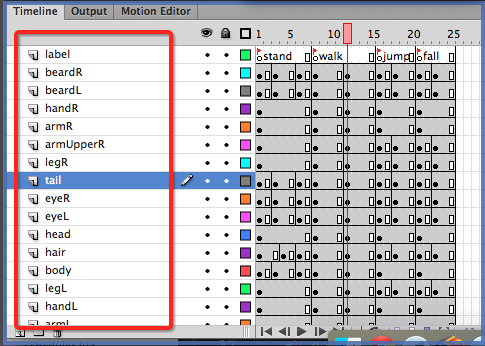
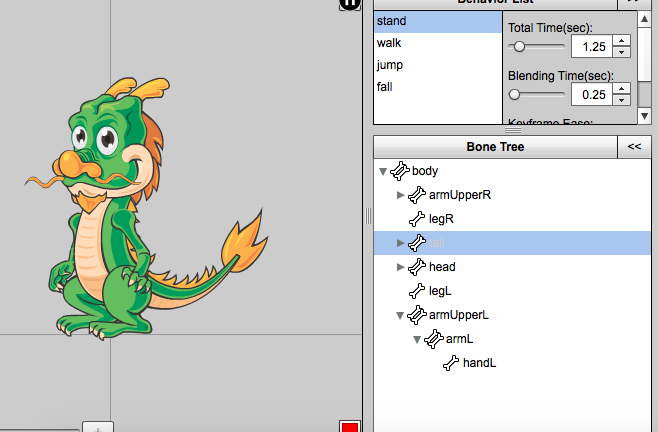
Why does the
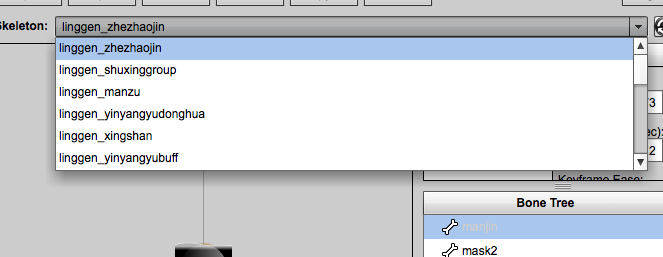
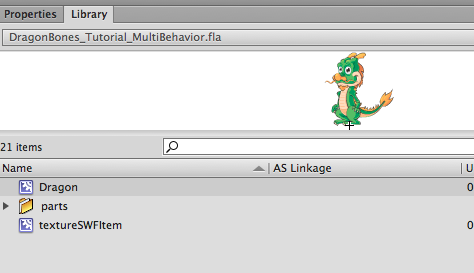
b node (child node of armature node)
<b name="tail" parent="body" x="45.9" y="-70.8" kX="30" kY="30" cX="1" cY="1" pX="11.5" pY="176.35" z="10">
Skeleton information, based on the first frame information.
name: The name of the bone is the name of the layer in TimeLine, as shown above.
parent: Bone parent node, pictured above.
x, y: The coordinates of the component rotation anchor point relative to the origin of the parent node, as shown in the figure below, the y direction is downward as the positive direction.
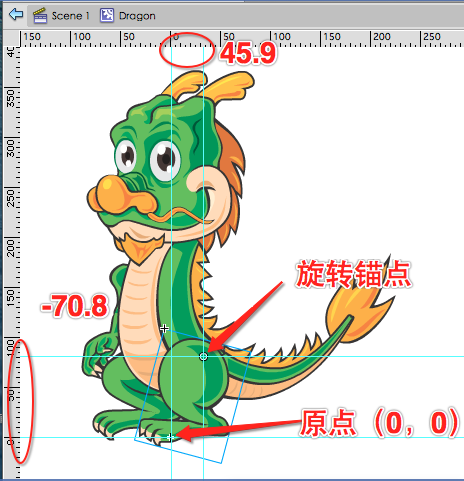
kX, kY: represents skewX and SkewY. Generally, the two are equal and represent the Rotate (rotation) size.
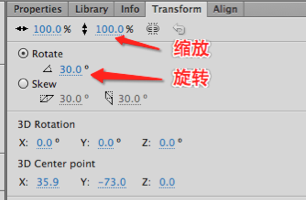
cX, cY: represents scaleX, scaleY, represents the zoom size.
pX, pY: represents pivotX, pivotY, the coordinates of the rotation anchor point relative to the origin of the component. The following figure adjusts the 30-degree rotation.
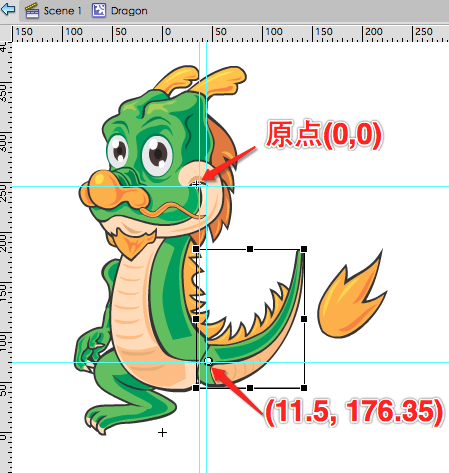
z: Level, the bottom layer is layer 0, increasing one by one.
d node
The nodes displayed in the skeleton can be understood as skin. If several components from the library are used in a layer, there will be several
<d name="parts-tail" pX="0" pY="-63.8"/>
name: Displays the name of the object, which is the concatenation of the path and component name in the library.
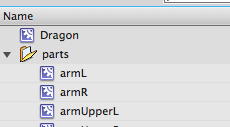
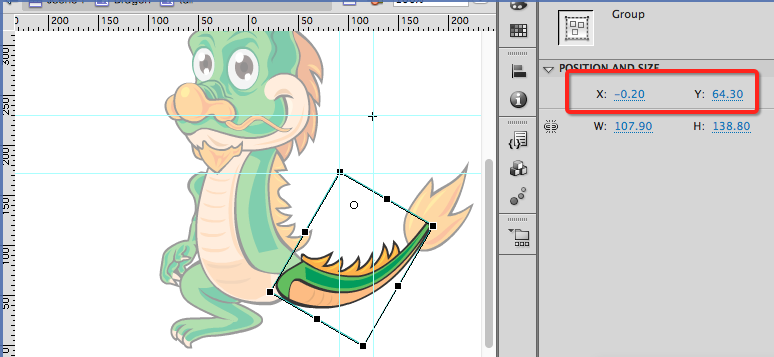
pX, pY: Display the displacement of the object relative to the origin.
animations node
The
<animations>
<animation name="Dragon">
<mov name="stand" dr="" to="" drTW="" lp="" twE="">
<b name="tail" sc="" dl="">
<f x="." y="-." cocosd_x="." cocosd_y="-." kX="" kY="" cX="" cY="" pX="." pY="." z="" dI="" dr=""/>
<f x="." y="-." cocosd_x="." cocosd_y="-." kX="." kY="." cX="" cY="" pX="." pY="." z="" dI="" dr=""/>
<f x="." y="-." cocosd_x="." cocosd_y="-." kX="" kY="" cX="" cY="" pX="." pY="." z="" dI="" dr=""/>
</b>
</mov>
<mov name="walk" dr="" to="" drTW="" lp="" twE="">
</mov>
<mov name="jump" dr="" to="" drTW="" lp="" twE="NaN">
</mov>
<mov name="fall" dr="" to="" drTW="" lp="" twE="NaN">
</mov>
</animation>
</animations>Why does
mov node
The mov node actually corresponds to an animation in the program. A frame label on TimeLine will generate a mov, so there will be multiple movs in one
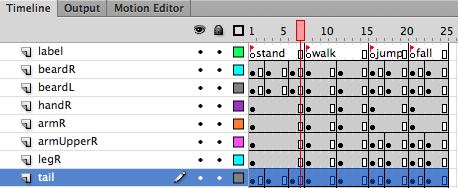
<mov name="stand" dr="7" to="6" drTW="30" lp="1" twE="0">
name: frame label name.
dr: represents duration, how many frames mov lasts. As shown in the above figure, stand lasts 7 frames.
to: I really don’t know what it does.
drTW: stands for duration_tween, how long the animation runs, 1/24*7=0.29s. Setting TotalTime on the dragonbones panel affects this value.
lp: stands for loop, whether to loop or not.
twE: I really don’t know what it does.
b node (child node of mov node)
Bone status, there will be all bone b nodes in mov.
<b name="tail" sc="1" dl="0">
name:骨骼名字
sc:代表movement_scale,不知是啥。总帧数调整,dragonBones面板可调整
dl:代表movement_delay,不知是啥。dragonBones面板中PlayDelay设置应该和其有关。
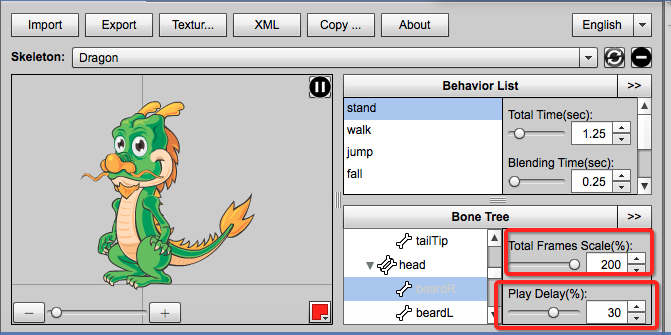
f节点
<f x="45.9" y="-70.8" cocos2d_x="124.1" cocos2d_y="-229.25" kX="30" kY="30" cX="1" cY="1" pX="11.5" pY="176.35" z="10" dI="0" dr="2"/>
对应关键帧信息。stand动画有3个关键帧,所以会有三个f节点。x,y,kX,kY,cX,cY,pX,pY,z与b节点(armature节点的子节点)中对应属性相同,cocos2d_x和cocos2d_y也不知道怎么来的。
dI:display_index 显示哪个图(
dr: duration 帧数.
TextureAtlas节点
dragonbone导出方式可以选择,如果选择导出大图,那么TextureAtlas节点代表了大图中小图的相关信息,可以理解成TexturePacker产生的plist文件,比如
<TextureAtlas name="Dragon" width="" height=""> <SubTexture/> <SubTexture name="parts-tail" width="" height="" cocosd_pX="" cocosd_pY="-." x="" y=""/> <SubTexture/> <SubTexture/> <SubTexture/> </TextureAtlas>
SubTexture节点为小图信息,width和height为长和宽,x和y为在大图中的坐标。cocos2dpX和cocos2dpY依然不晓得有什么用。
以上内容是脚本之家的小编给大家分享的cocos2dx骨骼动画Armature源码剖析(二),后续还有更近,请持续关注本站。

Hot AI Tools

Undresser.AI Undress
AI-powered app for creating realistic nude photos

AI Clothes Remover
Online AI tool for removing clothes from photos.

Undress AI Tool
Undress images for free

Clothoff.io
AI clothes remover

AI Hentai Generator
Generate AI Hentai for free.

Hot Article

Hot Tools

Notepad++7.3.1
Easy-to-use and free code editor

SublimeText3 Chinese version
Chinese version, very easy to use

Zend Studio 13.0.1
Powerful PHP integrated development environment

Dreamweaver CS6
Visual web development tools

SublimeText3 Mac version
God-level code editing software (SublimeText3)

Hot Topics
 Replace String Characters in JavaScript
Mar 11, 2025 am 12:07 AM
Replace String Characters in JavaScript
Mar 11, 2025 am 12:07 AM
Detailed explanation of JavaScript string replacement method and FAQ This article will explore two ways to replace string characters in JavaScript: internal JavaScript code and internal HTML for web pages. Replace string inside JavaScript code The most direct way is to use the replace() method: str = str.replace("find","replace"); This method replaces only the first match. To replace all matches, use a regular expression and add the global flag g: str = str.replace(/fi
 Build Your Own AJAX Web Applications
Mar 09, 2025 am 12:11 AM
Build Your Own AJAX Web Applications
Mar 09, 2025 am 12:11 AM
So here you are, ready to learn all about this thing called AJAX. But, what exactly is it? The term AJAX refers to a loose grouping of technologies that are used to create dynamic, interactive web content. The term AJAX, originally coined by Jesse J
 10 jQuery Fun and Games Plugins
Mar 08, 2025 am 12:42 AM
10 jQuery Fun and Games Plugins
Mar 08, 2025 am 12:42 AM
10 fun jQuery game plugins to make your website more attractive and enhance user stickiness! While Flash is still the best software for developing casual web games, jQuery can also create surprising effects, and while not comparable to pure action Flash games, in some cases you can also have unexpected fun in your browser. jQuery tic toe game The "Hello world" of game programming now has a jQuery version. Source code jQuery Crazy Word Composition Game This is a fill-in-the-blank game, and it can produce some weird results due to not knowing the context of the word. Source code jQuery mine sweeping game
 How do I create and publish my own JavaScript libraries?
Mar 18, 2025 pm 03:12 PM
How do I create and publish my own JavaScript libraries?
Mar 18, 2025 pm 03:12 PM
Article discusses creating, publishing, and maintaining JavaScript libraries, focusing on planning, development, testing, documentation, and promotion strategies.
 jQuery Parallax Tutorial - Animated Header Background
Mar 08, 2025 am 12:39 AM
jQuery Parallax Tutorial - Animated Header Background
Mar 08, 2025 am 12:39 AM
This tutorial demonstrates how to create a captivating parallax background effect using jQuery. We'll build a header banner with layered images that create a stunning visual depth. The updated plugin works with jQuery 1.6.4 and later. Download the
 Getting Started With Matter.js: Introduction
Mar 08, 2025 am 12:53 AM
Getting Started With Matter.js: Introduction
Mar 08, 2025 am 12:53 AM
Matter.js is a 2D rigid body physics engine written in JavaScript. This library can help you easily simulate 2D physics in your browser. It provides many features, such as the ability to create rigid bodies and assign physical properties such as mass, area, or density. You can also simulate different types of collisions and forces, such as gravity friction. Matter.js supports all mainstream browsers. Additionally, it is suitable for mobile devices as it detects touches and is responsive. All of these features make it worth your time to learn how to use the engine, as this makes it easy to create a physics-based 2D game or simulation. In this tutorial, I will cover the basics of this library, including its installation and usage, and provide a
 Auto Refresh Div Content Using jQuery and AJAX
Mar 08, 2025 am 12:58 AM
Auto Refresh Div Content Using jQuery and AJAX
Mar 08, 2025 am 12:58 AM
This article demonstrates how to automatically refresh a div's content every 5 seconds using jQuery and AJAX. The example fetches and displays the latest blog posts from an RSS feed, along with the last refresh timestamp. A loading image is optiona
 How do I optimize JavaScript code for performance in the browser?
Mar 18, 2025 pm 03:14 PM
How do I optimize JavaScript code for performance in the browser?
Mar 18, 2025 pm 03:14 PM
The article discusses strategies for optimizing JavaScript performance in browsers, focusing on reducing execution time and minimizing impact on page load speed.





